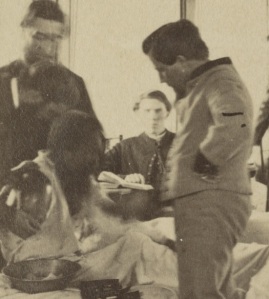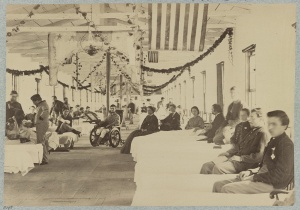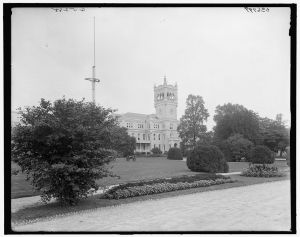The horrors of war were not only found on the battlefield, but also in the hospitals where soldiers and civilians shared in the emotional suffering. Drew Gilpin Faust’s This Republic of Suffering discusses how United States Sanitary Commission and Christian Commission workers tried endlessly to help care for the sick and wounded. As she explains, “The resources of the Sanitary Commission stretched only so far, however. For the most part the bereaved were forced to rely upon themselves and upon the emerging network of embalmers, undertakers, and private ‘agents,’ who followed the armies, finding work and profit for themselves in assisting grieving families who had little idea of how to find or retrieve their lost husbands, brothers, and sons.”
From Faust’s description, we can see the Soldiers’ Home cemetery placed within a much larger context of a mourning and suffering nation. Many of the bereaved had no idea where their loved ones were buried, and some didn’t even know their loved ones’ fates at all. The Soldiers’ Home National Cemetery provided families a place to grieve and mourn their loved ones, knowing they had provided a decent burial, a very important concept. According to Faust’s work on ideas about Civil War death, Americans stressed the importance of what she terms the “good death”, surrounded by family with personal acceptance of death.
Mary Lincoln played a role in helping ease this suffering. While she spent her summers at the Soldiers’ Home, she visited Washington hospitals and was known even to write letters home on behalf of soldiers too sick or maimed to write themselves. Such letters provided solace to worried families in the North, anxious about their loved ones in Union service.
Poet Walt Whitman also visited such hospitals. The Wound Dresser: A Series of Letters Written from the Hospitals in Washington During the War of the Rebellion, published in 1898, contains a passage Whitman wrote describing the harrowing scenes in the Washington hospitals:
“I do a good deal of writing letters by the bed-side, of course–writing all kinds, including love letters. Many sick and wounded soldiers have not written home to parents, brothers, sisters, and even wives, for one reason or another, for a long, long, time. Some are poor writers; some cannot get papers and envelopes; many have an aversion to writing, because they dread to worry the folks at home- the facts about them are so sad to tell” (28-29).

In this high-resolution, detailed image of the Armory Square Hospital photo (shown above), it appears that surgeons and hospital assistants are treating an amputee. Such digitized photos allow us to see the individual suffering of Civil War soldiers up close for the first time.
The aftereffects of battlefield wounds did not simply end with the war. Frank R. Freemon, in his 1998 work on Civil War medicine, Gangrene and Glory: Medical Care during the American Civil War, narrates the story of one veteran and resident of the Soldiers’ Home who lived for 38 years with a minie ball still lodged in his hand. As a macabre party trick, he rattled it within the cyst in his hand for visitors to listen to. He eventually had the bullet removed in 1902. Not only was the Soldiers’ Home a repository for the dead, but living Civil War veterans also maintained their presence long after Lincoln’s stay on the grounds. While living out the final years of their lives, the veterans told oral histories about their war experiences and stories they had heard about Lincoln’s time there.

